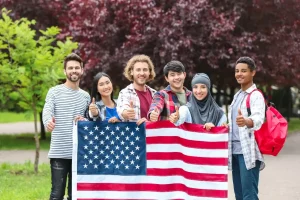
Why the U.S. Remains the Top Choice for International Students in 2025
Home Blog Why the U.S. Remains the Top Choice for International Students in 2025 By Rahul | U.S. Student Visa Specialist A Closer Look at
If you’re planning to study in the United States, figuring out the right visa can be confusing. The F1, J1, and M1 visas are the most common options, but each serves a different purpose. Choosing the wrong one could delay your plans or limit your opportunities.
At US Students Visa, we help international students with the US visas process smoothly. In this guide, we’ll break down the key differences between these visas so you can pick the best one for your situation.
The F1 visa is the most common choice for students enrolling in U.S. universities, colleges, high schools, or language programs.
Purpose: Fulltime academic studies (bachelor’s, master’s, Ph.D., etc.) Work Options: On campus jobs (up to 20 hours/week during school) Optional Practical Training (OPT) – 12 months (or 36 months for STEM fields) after graduation. Duration: Valid for your program length + 60 days (grace period). Dependents: F2 visa for spouses/children (they cannot work). Best For: Students pursuing degrees at accredited U.S. institutions who want work opportunities after graduation.
The J1 visa is designed for exchange programs, including study, internships, and research. Unlike the F1, it’s not just for degree seeking students.
Purpose: Exchange programs (study, work, research, or training). Work Options: Depends on the program (some allow employment). Academic Training (similar to OPT, duration varies). Duration: Varies by program (a few months to several years) . Dependents: J2 visa for spouses/children (*they can apply to work*). 2 Year Home Residency Rule: Some J1 holders must return home for 2 years before getting a green card or work visa. Best For: Students in short term exchange programs, au pairs, researchers, or professionals in training.
The M1 visa is for students enrolling in vocational or technical schools (e.g., flight school, cosmetology, mechanics).
Purpose: Nonacademic or vocational training. Work Options: No on campus or off campus work allowed. Limited practical training after program completion. Duration: Up to 1 year (*extensions possible, max 3 years*). Dependents: M2 visa for spouses/children (*cannot work*). Best For: Students pursuing hands-on training in trades like automotive repair, culinary arts, or aviation.
Which Visa Should You Choose?
Feature | F1 Visa | J1 Visa | M1 Visa |
Purpose | Degree programs | Exchange programs | Vocational training |
Work During Studies | Yes (limited) | Depends on program | No |
Post Graduation Work | OPT available | Academic Training possible | Limited |
Dependents Work? | No | Yes (J2) | No |
Duration | Program length + 60 days | Varies by program | Up to 1 year (extendable) |
Need a degree? → F1
Exchange program, internship, or research? → J1
Technical or trade school? → M1
Need Help Choosing or Applying?
At US Students Visa, we specialize in helping students like you secure the right visa for their U.S. education. Whether you’re applying for an F1, J1, or M1 visa, our experts can guide you through the process.
📧 Email us: [email protected]
📞 Call us: +1 (510) 8760888
Picking the right visa is important for your U.S. education and future career. The F1 is best for traditional students, the J1 for exchange experiences, and the M1 for skill based training.
Before applying, check your school’s requirements and consult an immigration expert if needed. Got questions? Contact US Students Visa today!

Home Blog Why the U.S. Remains the Top Choice for International Students in 2025 By Rahul | U.S. Student Visa Specialist A Closer Look at

Home Blog U.S. Pauses New Student Visa Interviews Amid Expanded Social Media Screening What Happened? On Tuesday, May 27, 2025, the U.S. State Department directed

Home Blog Harvard vs. Trump Administration: The Battle Over International Student Enrollment What Happened? On Thursday, May 22, 2025, the Trump administration abruptly revoked Harvard